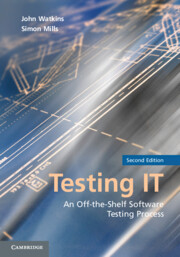Book contents
- Frontmatter
- Contents
- Foreword to the Second Edition by Geoff Thompson
- Foreword to the First Edition by Maurice Rosenburgh
- Acknowledgments
- 1 Introduction
- PART 1 THE TRADITIONAL TESTING PROCESS
- PART 2 THE TESTING PROCESS IN THE REAL WORLD: ILLUSTRATIVE CASE STUDIES
- PART 3 THE APPENDICES
- Appendix A Terms of Reference for Testing Staff
- Appendix B Testing Guides
- Appendix C Test Plan Document Template
- Appendix D Test Specification Document Template
- Appendix E Test Script Template
- Appendix F Test Result Record Form Template
- Appendix G Test Log Template
- Appendix H Test Certificate Template
- Appendix I Reuse Pack Checklist
- Appendix J Test Summary Report Template
- Appendix K Equivalence Partition Example
- Appendix L Boundary Value Analysis Example
- Appendix M State Transition Example
- Appendix N Pairwise Testing Example
- Appendix O Automated Testing Tool Selection Criteria
- Appendix P Usability Testing Overview
- Appendix Q Testing Process Health Check
- Appendix R The Testing of Object-Oriented Software
- Appendix S Pragmatic Test Process Adoption – a Real-World Example
- References
- Glossary
- Index
Appendix L - Boundary Value Analysis Example
Published online by Cambridge University Press: 03 May 2011
- Frontmatter
- Contents
- Foreword to the Second Edition by Geoff Thompson
- Foreword to the First Edition by Maurice Rosenburgh
- Acknowledgments
- 1 Introduction
- PART 1 THE TRADITIONAL TESTING PROCESS
- PART 2 THE TESTING PROCESS IN THE REAL WORLD: ILLUSTRATIVE CASE STUDIES
- PART 3 THE APPENDICES
- Appendix A Terms of Reference for Testing Staff
- Appendix B Testing Guides
- Appendix C Test Plan Document Template
- Appendix D Test Specification Document Template
- Appendix E Test Script Template
- Appendix F Test Result Record Form Template
- Appendix G Test Log Template
- Appendix H Test Certificate Template
- Appendix I Reuse Pack Checklist
- Appendix J Test Summary Report Template
- Appendix K Equivalence Partition Example
- Appendix L Boundary Value Analysis Example
- Appendix M State Transition Example
- Appendix N Pairwise Testing Example
- Appendix O Automated Testing Tool Selection Criteria
- Appendix P Usability Testing Overview
- Appendix Q Testing Process Health Check
- Appendix R The Testing of Object-Oriented Software
- Appendix S Pragmatic Test Process Adoption – a Real-World Example
- References
- Glossary
- Index
Summary
Introduction
This appendix contains an example illustrating the testing technique of boundary value analysis described in Chapter 3, which the test analyst can use to select specimen data for use in testing the application under test (AUT). This example uses the same testing problem as that presented in Appendix K – Equivalence Partition Example.
The Testing Problem
The specification for a software system for validating expenses claims for hotel accommodation includes the following requirements:
There is an upper limit of £90
Any claims above £90 should be rejected and cause an error message to be displayed
All expense amounts should be greater than £0 and an error message should be displayed if this is not the case.
Analyzing the Testing Requirements
To support the process of analyzing the previous requirement, it is of benefit to graphically show the boundaries and to determine the boundary values and significant values either side of the boundaries (see Figure L1).
Designing the Test Cases
The next step is to design the test cases by drawing up a table showing the test case ID, the values about and on the boundary to be input for the test, the boundary it tests, and the expected output or result of the test case (see Table L1).
Information
- Type
- Chapter
- Information
- Testing ITAn Off-the-Shelf Software Testing Process, pp. 270 - 271Publisher: Cambridge University PressPrint publication year: 2010
